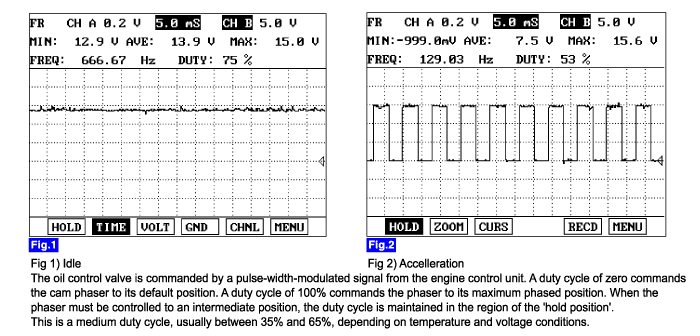

PCM controls OCV(Oil Contol Valve) with PWM (Pulse Width Modulator) signal to change oil passages supplying oil to CVVT that makes CAM postion changes (advance or retard). OCV is integrated with oil filter and located at the nearest CVVT on the engine block.
As the cam phaser is advanced and retarded, its position is measured using a toothed wheel.
The wheel is attached to the camshaft, or to the cam phaser rotor. A sensor picks up the signal from the wheel and its output is read by the engine control unit. A cam signal is generated for each cam phaser on the engine. This requires a separate toothed wheel and cam sensor combination for each cam phaser. The cam signal and crankwheel signal are compared as the engine turns, and the phasing position is determined. The position is displayed in crank angle degrees, relative position from default. This position measurement is used as feedback for the position control software, which determines the required percent duty cycle commanded to the oil control valve.
When the enable condition is satisfied, the PCM checks that OCV outputs (Voltage level) are observed when OCVs are commanded. When a OCV output failure is detected, the appropriate fail counter is incremented.
If the failure threshold is exceeded 5 seconds during one diagnostic test(10second), the test is failed and DTC is stored. MIL(Malfunction Indication Lamp) turns on when the malfunction lasts till consecutive 2 driving cycle.
Item | Detecting Condition | Possible cause |
DTC Strategy | ● Detects a short to battery of OCV circuit | ● Poor Connection ● Short to battery in Control Circuit ● OCV ● PCM |
Enable Conditions | ● No disabling Faults Present ● Engine Running ● 11V ≤ Ignition Voltage ≤ 16V ● Enable Time delay ≥ 0.5sec | |
Threshold value | ● Short to battery | |
Diagnosis Time | ● Continuous (More than 5 seconds failure for every 10 seconds test ) | |
MIL On Condition | ● 2 Driving Cycles |
Resistance (Ω) | 6.7 ~ 7.7 |
